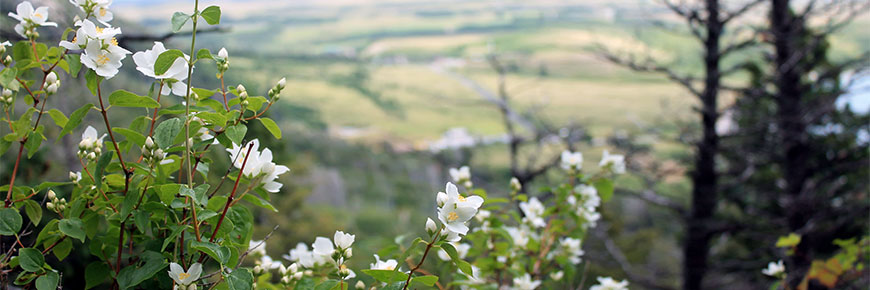
Green scene
Waterton Lakes National Park
With its merging landforms, connected ecoregions and its mild, moist, windy climate, Waterton Lakes National Park is an amazing meeting place for an abundant and diverse collection of vegetation.
This living landscape includes an interesting group of small ferns called moonworts; tiny reflections of Waterton's unusually diverse plant life.
Despite it's small size (505 sq km) Waterton is graced with over 1000 species of vascular plants . Over half of Alberta's plant species are found in this tiny place. The park's four ecoregions - foothills parkland, montane, subalpine and alpine - embrace forty-five vegetation communities. Sixteen of these are considered significant because they are rare or fragile and threatened.
Waterton also has an unusually high number of rare plants - over 175 are provincially rare (e.g. mountain lady's-slipper, pygmy poppy, mountain hollyhock), and over twenty of these are found only in the Waterton area (e.g. western wakerobin, Lewis' mock-orange, white-veined wintergreen). Over 50 species are rare in Canada (e.g. Bolander's quillwort, Lyall's scorpionweed, Brewer's monkeyflower.)
Many of the unusual plants in Waterton like beargrass and pink meadowsweet are more commonly found west of the continental divide. They are present here because the prevailing Pacific weather systems spill over the divide, bringing coastal conditions and windborne seeds.
Climate features - moisture, temperature, light and wind - are an important influence on the distribution of plants. A major factor affecting plants is the amount of available moisture. In Waterton, average annual precipitation varies greatly from grassland to mountain peak. This wide range influences the types of plants found in any given area in the park.
The type of soils can also play a role. For example, Waterton's prairie soils are layered above porous glacial till, resulting in quick drainage of moisture. This, in combination with the drying effect of frequent winds, creates conditions where prairie-adapted plants grow.
Moving up a mountainside can be compared to moving closer to the arctic circle. Plants on Waterton's mountaintops are similar to those in the Arctic tundra.
Change is also seen from one side of a moutain to the other. South facing slopes receive more sunlight, so tend to be warmer and drier than north facing slopes. This can shift plant communities up south faces, and may affect the types of plants growing there as well.
Just as plants shape animal communities, animals can shape plant communities. Herbivores, from microscopic critters to elk, can influence the abundance of a particular plant species. The abundance of herbivores, in turn, affects predators. Insects, such as mountain pine beetles, can also strongly affect plants. Clearly, plant and animal communities are closely interrelated.
Throw in natural processes like floods, avalanches, fire, and rock slides and you begin to understand why Waterton's plant communities are so diverse.
Related links
- Date modified :